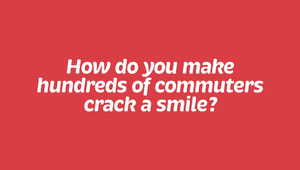
Break Rules So Your Advertising Isn’t Received Like “Flaccid Sandwich At A Conference”

Marketing people love rules. Frameworks. Playbooks. Guardrails. Conventions—they’re our industry’s comfort food. And why not? We’re all desperately searching for ideas that work and the rules tell us what’s worked before. They simplify complexity. They make us sound smart. They look nice on PowerPoint slides. And yes, many of them are proven to help brands grow.
But when everyone’s following the same familiar playbook, we arrive at familiar outcomes. And from that point, the brand with the fattest wallet wins— which is a problem for most. That’s why, at SXSW in Austin, we didn’t just challenge marketing’s bad rules—we stuck them in a shredder live on stage. Not just to be rebellious and dramatic (okay, partly because of that) but because challenging rules is essential to creating something worthy of people’s attention.
Marketing has become overly reliant on rules. Marketers have become, as Zoe Scaman puts it, “Accountants of Attention,” peddling a data-backed science that tells us exactly what to say, where to say it, and how many times to repeat it before the consumer finally gives in - accepting your message like a flaccid sandwich at a conference. We put so much emphasis on such simple metrics—just because they’re the easiest to measure. We rely on data to validate instead of trusting creativity to lead. We’re so obsessed with managing potential downside risk, that we diminish the upside opportunity in the process.
Challenging rules and ruffling feathers has always been in our agency's MO. TABOO wasn’t born in a boardroom - it was born on the streets, at festivals, in conversations with people who didn’t care about the "right way," but cared deeply about things that interested them.
It’s an agency built on tension—two brothers, two radically different approaches. One, an advertising outsider armed only with street smarts, gut instinct, and a knack for making shit happen; the other, a seasoned strategist schooled by the best in the advertising industry, in Australia and the US. When those worlds collided, what emerged was a relentless curiosity about which rules actually help brands grow and which ones are holding them back.
Last year at SXSW, we broke one of the most sacred rules of conference etiquette, “When presenting at a prestigious conference - always keep your clothes on”, and stripped off in front of a full auditorium. We did it to prove a point – the road to impact is paved with discomfort, risk, and vulnerability. Our stunt got a lot of attention, even earning TABOO a chapter in US marketing legend Mark Schaefer’s new bestselling book ‘Audacious’. So when SXSW surprised us, not with a subpoena for indecency, but with an invitation back, we agreed to keep our clothes on and stripped the marketing rule book instead.

Here are just a few of the rules that went down shredder:
Golden Rule 1: Never Attach Your Brand to a Negative Emotion
Conventional wisdom tells us people want happiness, not negativity. Associate your brand with positive emotions, and you’ll be positively rewarded.
The problem with this is it assumes people only want to feel good. Actually, what they crave most is to feel understood. Life is messy, stressful, frustrating, and brands that only sugar-coat reality fail to connect. The brands that win aren’t the ones that project images of perfection, they’re the ones that make us feel seen and understood.
Coors recently tapped into a universally hated experience—Mondays, particularly the Monday after Super Bowl. Instead of focusing on “drinking beers with your buddies watching the big game!”, Coors owned the struggle of the day after. And it stood out like sloth’s balls.
Golden Rule 2: Don’t Alienate Any Consumer Segment
Logic tells us that the best way to grow a brand is to make it appealing to everyone. The bigger the audience, the bigger the opportunity to grab wallets.
In trying to appeal to everyone, brands sand back the edges, dodge opinions, and strip away tension. In doing so, they alienate a huge amount of people, not by being controversial, but by being completely and utterly ignorable.

If nobody hates it, chances are nobody loves it either.
When brands try to appeal to everyone, they create the commercial equivalent of hotel art.
Hotel Art is always there - we all see it (millions of impressions!), but it means absolutely nothing to anyone.
Golden Rule 3: Attention Spans Are Shrinking - The Shorter Your Message, The Better
We’re told that attention spans are getting smaller, and so we need to cram our logo and key message down people’s throats in two seconds. But are attention spans getting shorter or is just our patience for boring content? Audiences binge-watch entire Netflix series and consume hours upon hours of podcasts, then scroll their way through the entire contents of TikTok —they have patience, just not for things that aren’t very interesting.
If your audience isn't paying attention - they're not the problem, you are.
This mindset has given rise to what we call the “brand flash” -- a self-centred exposure to one’s audience with no regard for mutual value.

In the fight to be right, too many brands overlook the need to be interesting. And the truth is, your audience doesn’t care that you’re right, they only care that you’re interesting. If you fail that step, the door to get to their feels remains firmly shut.
The brands that actually matter—the ones people genuinely talk about, debate, defend and buy—don’t win by obediently following someone else’s playbook. They win by daring to rip it up entirely. Because in marketing, the biggest risk isn’t breaking the rules; it’s being so compliant that nobody even noticed you were there.















